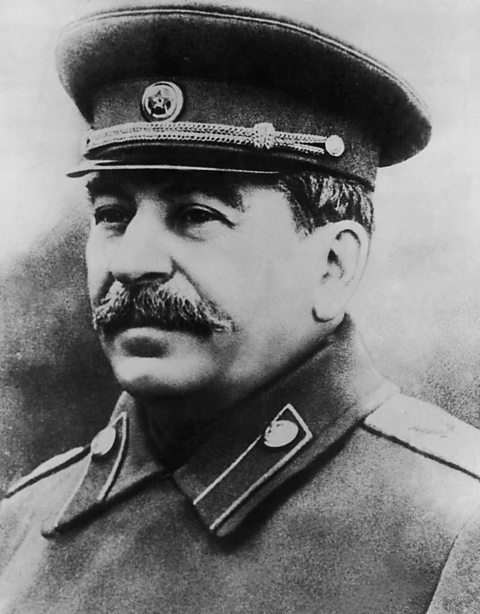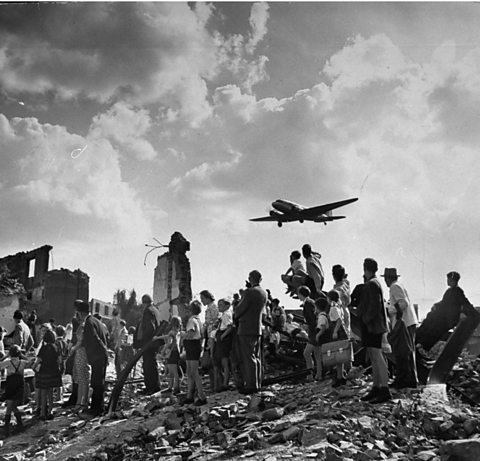Berlin Blockade and Airlift, 1948-49
Background
Ever since the Yalta Conference, it had been clear that Berlin was going to be a flash point in the Cold War, and this came to a head in 1948. The settlement agreed at the end of World War Two at Potsdam in 1945 was a temporary one. The Grand Alliance could not agree on a permanent united German state, and so the temporary zones of occupation had been created. Stalin was concerned that the Western powers would force the creation of a single capitalismAn economic system based on privately owned, as opposed to state-controlled, businesses and the creation of profit. Germany, by joining their zones together and overpowering the East.
- Germany had been divided into four zones of occupation each controlled by one of the Allies.
- Berlin had been the capital of the German Empire from 1871 to 1945, and it lay inside the Russian zone after World War Two. The Allies decided that it should also be divided into four zones of occupation.
- Access to Berlin for the Allies was by way of road, rail and canal, and via three specific air corridors.
What caused the Berlin Blockade?

Stalin was very aware that the western part of Germany was always going to be more prosperous and secure than the eastern zone. It was not a case of вҖҳtwo halvesвҖҷ of Germany. There were considerable differences between the west and the east. Stalin was worried that the west would take advantage of their stronger position and unite all their zones and eventually take over the eastern part.
What were the Western Allies doing in Berlin that made Stalin so upset?
- Using money from the Marshall Aid programme, the Allies were helping the Germans to rebuild their economy. They introduced a new, stable currency that would be used throughout their zones and they created jobs for workers in the Western sectors.
- At a meeting in London in January 1948, Britain and the USA joined their zones together to create вҖҳBizoniaвҖҷ and make it easier to administer them. (France would later join and theyвҖҷd change the name to West Germany).
On 24 June 1948, Stalin cut all land access to Berlin for the Allies. This became known as the Berlin Blockade. Stalin did not intend to risk war over Berlin, and he did not intend to вҖҳdrive the Allies outвҖҷ. More likely, his intention was to show that the Soviets also had power in Germany, that could match the demonstrations of economic power and unity that the West had just shown. He was using the Blockade as a lever to prevent any further Western moves in Germany, rather than attempting some kind of communismA classless society where all property is owned publicly. rollback.
"Cabinet discuss crisis in Berlin"
What did the Berlin Blockade mean for West Berlin?
- Berlin could now only be accessed by air, resulting in a restriction on the freedom to travel outside Berlin for all Germans.
- A shortage of food - West Berlin only had enough food for 36 days.
- A lack of basic goods like fuel and medicines.
The reaction of the Western Allies

The Berlin Blockade was the first serious clash between the members of the former Grand Alliance, and from here on in it was very clear that the Cold War had begun.
The Western Allies were not prepared to risk armed conflict with the Soviets to open the way to West Berlin. They decided that their sectors of Berlin would be supplied by air. This became known as the Berlin Airlift and it lasted for eleven months until the Blockade was lifted in May 1949.
At the height of the Berlin Airlift, a plane landed at BerlinвҖҷs Templehof Airport every minute. Keeping West Berlin supplied in this way cost the USA $350 million and Britain ВЈ17 million.
Similarly, Stalin was not prepared to use force to keep the Western Allies from supplying West Berlin by air, because he didnвҖҷt want to risk a war.
The aftermath of the Berlin Blockade
- The asymmetry of Germany and Berlin would remain a source of tension in Europe for the duration of the Cold War.
- In April 1949 the USA, Britain and France officially announced the formation of the German Federal Republic (West Germany).
- Elections in the Germany Federal Republic in August 1949 resulted in victory for the anti-communist politician, Konrad Adenauer, and the Christian Democratic Union.
- The formation of NATO (the North Atlantic Treaty Organisation) вҖ“ an alliance of countries around the North Atlantic for their mutual defence.
- Stalin responded to the formation of NATO with the Warsaw Pact вҖ“ similarly an alliance of the communist countries of Eastern Europe for their mutual defence.
- Finally, on 29 August 1949, the USSR exploded its first atomic bombA powerful and destructive bomb that gets its power from the energy released when atoms are split.. The USA no longer had a monopolyA market where there is only one seller of a particular good or service. on nuclear weapons.
Revision tip
Generally, all Western actions were matched by the USSR. Learn the pairs and their dates!
Politics: Truman Doctrine (1947) vs Cominform (1947)
Economics: Marshall Plan (1948) vs Comecon (1949)
Military: NATO (1949) vs Warsaw Pact (1955)